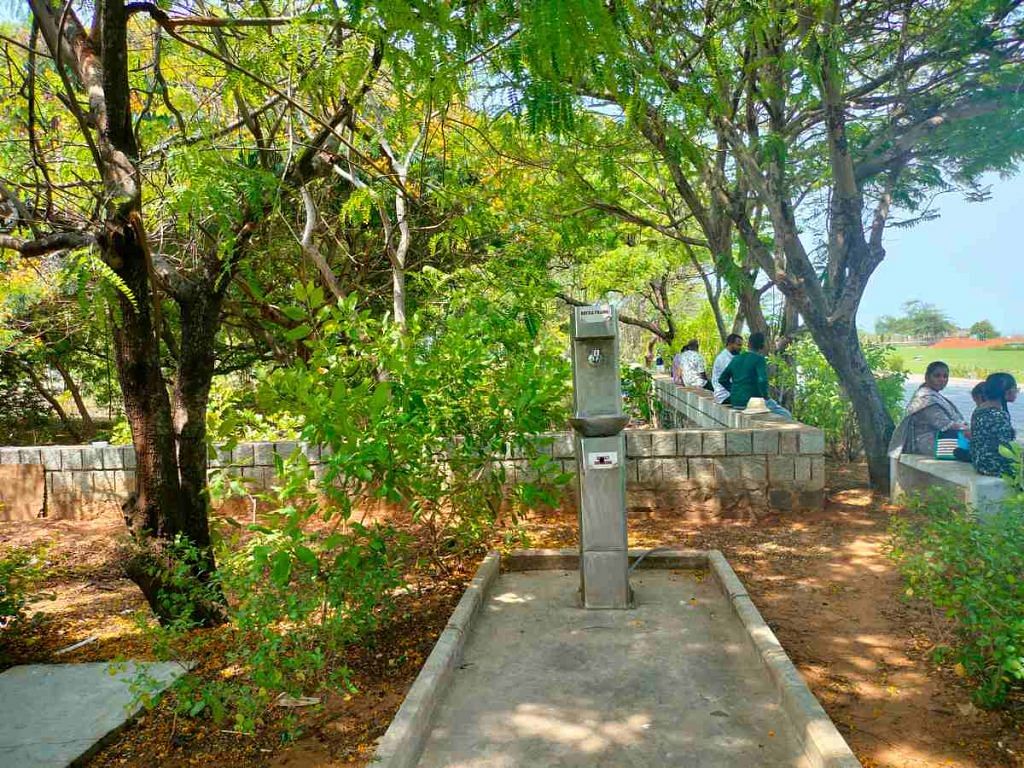Chennai: Braving the sweltering heat, 43-year-old Rajalakshmi steers her electric buggy through the stone pavements ferrying tourists to and from the 1200-year-old Mahabalipuram Shore Temple. Tamil Nadu’s postcard heritage temple is now entirely green, a first for an archaeological site in India.
The temple, which receives around 8,000 visitors every day, is now lit up by solar energy. Its garden, with 50 native saplings, thrives on recycled water. An in-house water purifier supplies drinking water at three locations within the temple complex. Electric buggies provide smooth, emissions-free sightseeing at the UNESCO World Heritage Site.
These eco-friendly initiatives are part of the Green Heritage Project by the Chennai-based nonprofit Hand in Hand India. It’s funded by the Renault Nissan Technology and Business Centre India (RNTBCI) and has the blessings of the Archaeological Survey of India (ASI).
“We wanted to renovate the monument in an ecologically friendly manner. So, we proposed the idea to RNTBCI and they agreed to fund it as part of their CSR (corporate social responsibility) initiative. Then we had a meeting with the government officials. They accepted it as well,” said G Kannan, vice president of Hand in Hand India.
Kannan said his organisation coined the tag of “India’s first green archaeological site” to draw attention to its uniqueness.

Meanwhile, other local NGOs are also planning green projects for heritage sites, according to D Sridhar, conservation assistant at the Mahabalipuram subcircle of the ASI.
So far, he said, the ASI has received proposals for renovating the Tiger Cave in Salavankuppam, a hamlet about 7 kilometres from Mahabalipuram, and another monument in Kancheepuram district.
Located about 60 km from Chennai, the Mahabalipuram Temple, built in 725 AD by the Pallava Dynasty, is famous for its intricate granite architecture and is one of the most popular tourist destinations in Tamil Nadu.
While the ‘green’ tag has not boosted tourist numbers majorly, the initiative has improved temple management and visitor experience by cutting down electricity consumption, ensuring plentiful water supply, and providing convenient transportation options.
Also Read: How do you really look at a Tamil Nadu temple? Chennai lecture series is helping
Solar energy, sitting areas, selfie point
More foreign tourists visited the Mahabalipuram Temple in 2021-2022 than the Taj Mahal, renewing focus on upgrading its visitor facilities to ‘world-class’ standards.
Kannan said that the decision to renovate the temple ecologically stemmed from the ASI’s limited funds to manage many heritage sites. Initially, the plan was to implement only a solar power system with a budget of Rs 1 crore. But eventually, more components were added, increasing the expenditure to Rs 2.6 crore. The project began in 2020 and was completed in 2023.
The team installed three solar plants with 10 KW capacity each, conserving 25,200 KWh of energy between February 2023 and March 2024, according to the project completion report submitted by Hand in Hand India to the ASI in March. Although the temple consumes only about 18 KW of energy every day, the 30 KW installation was designed to meet future needs, Kannan said.
They also set up a 500-litre-per-hour (LPH) drinking water plant at three locations within the monument compound. The wastewater generated by the plant is used to water a garden where with 50 almond trees have been planted. The NGO claims that the water plant has also reduced plastic bottle waste on the premises.

As for green cover, the saplings are growing nearly 400 metres away from the temple complex, as planting trees inside the main complex is not permitted. Kannan said there are guidelines on not planting trees in front of the temples to avoid obstructing the view from the entrance.
Other new facilities are geared toward making sightseeing more enjoyable.
Three solar-powered buggies, operated by local women, provide free transportation for the elderly, pregnant women, and people with disabilities. The organisation has also installed benches in the compound and nine bollards at the entrance, along with a selfie point to attract young tourists.
Rajalakshmi is one of four local women employed by Hand in Hand India for on-ground tasks. The women earlier managed everything from maintaining the garden and infrastructure to driving the buggies until the project’s completion. Afterward, ASI employees took over maintenance, while Rajalakshmi and her team continue driving the buggies.

Rajalakshmi said that she was selected after a rigorous hiring process that tested her communication, driving, and hospitality skills.
“Twenty-five women attended the tests. Proficiency in English and Tamil was a must, beside a license in four-wheeler driving,” she said, adding that the tests were followed by 10 days of training, after which four women, including herself, were selected.
The buggy operation, inaugurated in 2022 by then Chengalpattu district collector AR Rahul Nath, was the first step in implementing the project. Rajalakshmi, who was recently promoted to a supervising role, said NGO officials visit once a month or as needed for maintenance work.
Also Read: Mathura culture, Mahabharata Period — ASI digs Govardhan Hill after 50 years
‘Monuments are at risk’
The NGO conceived and implemented the Green Heritage Project, but the ASI oversaw it from start to finish. Kannan said the team faithfully followed guidelines from ASI officials in Mahabalipuram and Chennai.
ASI’s D Sridhar welcomed the initiative, noting that many of Mahabalipuram’s monuments are at risk due to pollution, sea exposure, and climate change.
“If we don’t protect them, they’ll be destroyed in the next 10 to 20 years,” he warned,adding that increasing tree cover in the region would help shield monuments from wind pressure and carbon emissions.
Sridhar pointed out that the ASI often struggles with funding for extensive projects, but is currently reviewing proposals from other organisations to green up other heritage sites.
But the ASI official added a word of caution— illuminating the temple at night, which was part of the initiative, could harm the ancient structures.
Many local shop owners, meanwhile, said they were unaware of the Green Heritage Project, except for the selfie point and a board indicating project completion at the main entrance.
Kannan said the NGO didn’t intend to increase the tourist footfall through the project and didn’t market it. It did, however, conduct multiple awareness drives involving students, volunteers, and politicians during the project execution period.
“Our idea is to have the monument green and clean. And for the tourists to have a good experience,” he said.
(Edited by Asavari Singh)






